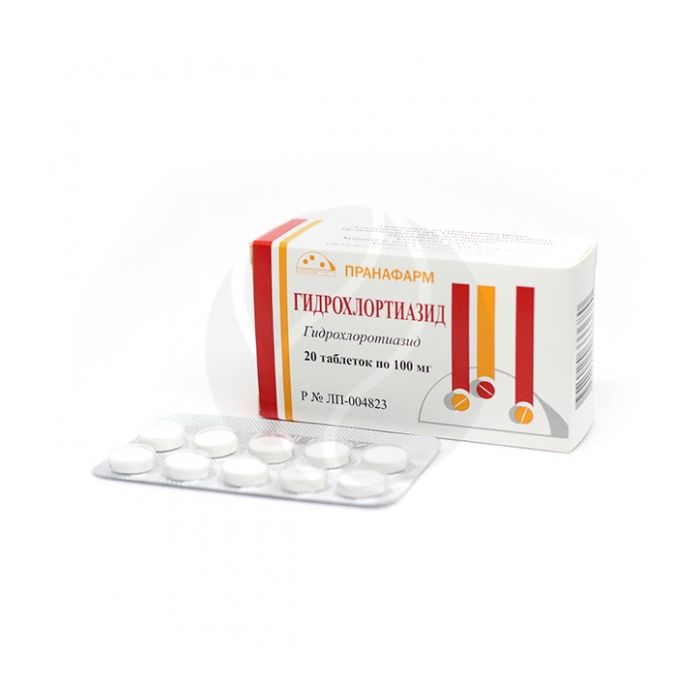Hydrochlorothiazide tablets 100mg, No. 20 Prana
Expiration Date: 05/2027
Russian Pharmacy name:
Гидрохлоротиазид таблетки 100мг, №20 Прана
Set individually. A single dose is 25-50 mg, a daily dose is 25-100 mg. The frequency of admission depends on the indications and the patient's response to treatment.
active substance: hydrochlorothiazide
Severe renal dysfunction, liver failure, severe gout and diabetes mellitus, hypersensitivity to sulfonamides.
pharmachologic effect
Thiazide diuretic. Violates the reabsorption of sodium, chlorine and water ions in the distal tubules of the nephron. Increases the excretion of potassium, magnesium, bicarbonate ions; retains calcium ions in the body. The diuretic effect occurs after 2 hours, reaches a maximum after 4 hours and lasts up to 12 hours. It helps to reduce elevated blood pressure. In addition, it reduces polyuria in patients with diabetes insipidus (the mechanism of action is not fully understood). In some cases, it lowers intraocular pressure in glaucoma.
Pharmacokinetics
After oral administration, 60-80% of the dose is absorbed from the gastrointestinal tract. The time to reach Cmax in plasma is 1.5-3 hours. Hydrochlorothiazide accumulates in erythrocytes. In the elimination phase, its concentration in erythrocytes is 3-9 times higher than in plasma. Plasma protein binding - 40-70%. Vd in the terminal phase of elimination is 3-6 l / kg (which is equivalent to 210-420 l with a body weight of 70 kg). Hydrochlorothiazide is metabolized to a very small extent. Its only metabolite found in trace amounts is 2-amino-4-chloro-M-benzenedisulfonamide. Excretion of hydrochlorothiazide from plasma is biphasic: T1 / 2 in the initial phase is 2 hours, in the terminal phase - about 10 hours. In patients with normal renal function, excretion is carried out almost exclusively by the kidneys. In general, 50-75% of the dose taken orally is excreted in the urine unchanged.In elderly patients and with impaired renal function, the clearance of hydrochlorothiazide is significantly reduced, which leads to a significant increase in its concentration in the blood plasma. The decrease in clearance observed in elderly patients appears to be associated with impaired renal function. In patients with cirrhosis of the liver, changes in the pharmacokinetics of hydrochlorothiazide are not observed.
Side effect
From the digestive system: nausea, vomiting, diarrhea; rarely - pancreatitis. From the side of the cardiovascular system: orthostatic hypotension, tachycardia. From the side of metabolism: hypokalemia, hypomagnesemia, hyponatremia, hypochloremic alkalosis, hyperuricemia, hypercalcemia. From the endocrine system: hyperglycemia. From the hematopoietic system: rarely - neutropenia, thrombocytopenia. From the side of the organ of vision: rarely - visual impairment. From the side of the central nervous system and peripheral nervous system: weakness, fatigue, dizziness, paresthesia. Allergic reactions: rarely - allergic dermatitis.
Application during pregnancy and lactation
There have been no adequate and well-controlled clinical studies of the safety of hydrochlorothiazide in pregnancy. In experimental studies, there were no signs of adverse effects on the fetus. Given this, use during pregnancy is possible only for health reasons and only if the intended benefit to the mother outweighs the potential risk to the fetus. Hydrochlorothiazide passes into breast milk. It is recommended to avoid the use of hydrochlorothiazide in the first month of breastfeeding, as there are reports of suppression of lactation.
Application for violations of liver function
Contraindicated in liver failure.
Application for impaired renal function
Contraindicated in severe renal impairment. In patients with renal insufficiency, systematic monitoring of plasma concentrations of electrolytes and CC is necessary.
special instructions
Use with caution in patients with gout and diabetes mellitus. In patients with renal insufficiency, systematic monitoring of plasma concentrations of electrolytes and CC is necessary. When signs of potassium deficiency appear, as well as with the simultaneous use of cardiac glycosides, GCS and ACTH, the appointment of potassium preparations or potassium-sparing diuretics is indicated. With long-term use, a diet rich in potassium should be followed. The simultaneous use of diuretics with NSAIDs is not recommended.
Drug interactions
With the simultaneous use of antihypertensive drugs, non-depolarizing muscle relaxants, their effect is enhanced. With the simultaneous use of barbiturates, diazepam, ethanol, the risk of orthostatic hypotension increases. With simultaneous use with GCS, there is a risk of hypokalemia, as well as orthostatic hypotension. With simultaneous use with ACE inhibitors (including captopril, enalapril), the antihypertensive effect is enhanced. Severe arterial hypotension is possible, especially after taking the first dose of hydrochlorothiazide, apparently due to hypovolemia, which leads to a transient increase in the hypotensive effect of the ACE inhibitor. The risk of impaired renal function increases. The development of hypokalemia is not excluded. With the simultaneous use of oral hypoglycemic drugs, their effectiveness decreases.With the simultaneous use of calcium and / or vitamin D preparations in high doses, hypercalcemia and the risk of developing metabolic acidosis due to a slowdown in the excretion of calcium in the urine under the influence of thiazide diuretics are possible. With simultaneous use with allopurinol, the risk of developing allergic reactions increases, especially in patients with impaired renal function. With simultaneous use with digoxin, an increase in the risk of developing glycosidic intoxication is possible. With simultaneous use with indomethacin, piroxicam, naproxen, phenylbutazone, a slight decrease in the hypotensive effect is possible. With simultaneous use with irbesartan, the development of an additive hypotensive effect is possible. With simultaneous use with carbamazepine, there are reports of the development of hyponatremia. When used simultaneously with colestipol,cholestyramine decreases absorption and diuretic effect of hydrochlorothiazide. With simultaneous use with lithium carbonate, it is possible to increase the concentration of lithium salts in the blood to a toxic level. When used simultaneously with orlistat, the effectiveness of hydrochlorothiazide decreases, which can lead to a significant increase in blood pressure and the development of a hypertensive crisis. With simultaneous use with sotalol, hypokalemia and the development of ventricular arrhythmias of the 'pirouette' type are possible.With simultaneous use with sotalol, hypokalemia and the development of ventricular arrhythmias of the 'pirouette' type are possible.With simultaneous use with sotalol, hypokalemia and the development of ventricular arrhythmias of the 'pirouette' type are possible.
'
